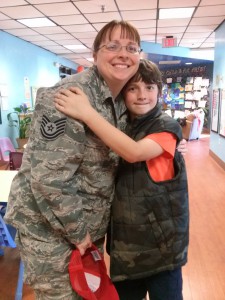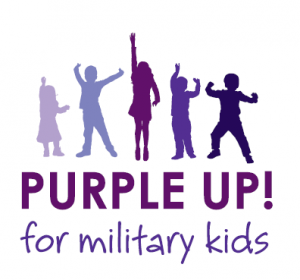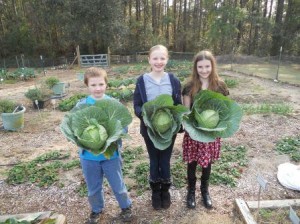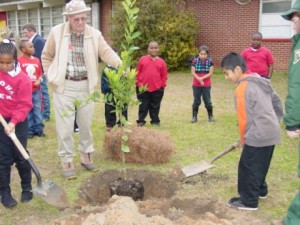by pmdavis | Apr 8, 2015
Most people think of the color green when they think of 4-H, but on April 10th, 4-H youth and volunteers in Florida will be sporting the color purple to show support for our military families. When we think of honoring our military, we often think of Memorial Day and Veterans Day. Did you know there is also a time identified to honor military children? Since 1986, April has been designated Month of the Military Child. This allows us to honor military children for their commitment and sacrifice. Here in the Florida Panhandle we have over 27,800 military youth who deal with situations like having their parents in harm’s way when they deploy.

Imagine if someone close to you were deployed. Would you like to see all the news reports showing bombs exploding and people shooting at each other? How would you feel about having long and repeated separations when your parent misses important events like birthdays, holidays, school and sporting events? Would you like it if your family had frequent relocations/moves? Every time families move, children have to make new friends, get used to new schools, and find new 4-H clubs and teams to join.
A lot of military children take these changes in stride and some even thrive on them, but it is hard also – kids have to rebuild their world every time they move. UF/IFAS Extension and 4-H are proud to be a part of the military family working with youth centers across the nation to have some consistency for youth in these situations and who are making these moves. Here locally we want you to join us in showing your support.
So what can you do to show them that we appreciate their sacrifices?
1. Participate in the 4th annual Purple Up! For Military Kids. Wear purple on Friday, April 10th, as a visible way to show support and thank military children for their strength and sacrifices. Why purple? Purple is the color that symbolizes all branches of the military, as it is the combination of Army green, Coast Guard blue, Air Force blue, Marine red and Navy blue.
2. Ask others to Purple Up! We hope everyone will take this opportunity to appreciate and celebrate these young heroes and to thank military families for their support and the freedoms they provide us by their service and sacrifices. Here are a few ideas:
- Ask your local, regional, state, and federal officials to wear purple on April 10th

- Engage fraternal organizations, social clubs, and Rotary groups
- Request local businesses to post a Purple Up! message on their roadside signs
- Ask stores and restaurants to put a Purple Up! flyer in their business window
- Suggest companies and businesses ask their employees to wear purple
- Invite coworkers, as well as members of your spiritual community, exercise class, or golf league to join you in showing support for the military youth in your town by wearing purple on April 10th.
For more information, contact Paula Davis, Ed.D. at the Bay County Extension Office at 850-784-6105. All programs are open to all persons regardless of race, color, age, sex, handicap or national origin.
by jgl1 | Nov 8, 2013
John G. Lilly
jgl@ufl.edu
Jefferson County Extension Director/4-H Agent
Young people in 4-H are committed to improving their communities. Dr. Richard Lerner, and the team at the Institute for Applied Research in Youth Development at Tufts University highlights a notable trend. 4-H youth are three times more likely to actively contribute to their communities when compared with youth who do not participate in 4-H. (more…)
by vmullins | Apr 26, 2013

Teens learn valuable life skills through volunteering with 4-H.
Summer – no school, lots of time – what’s a teen 4-Her going to do? Many teens will be searching for jobs. Some will be looking for summer employment to pay for 4-H events, or earn extra spending money, or save for a car, clothes or college. But will they find a job? Some won’t. If they can’t get a job, encourage them to volunteer!
The current job market is dismal. Pick up any newspaper, turn on any news program or just listen to the people around you. It’s hard to get a job! The job employment rate for American teens is at an all-time low.
Teens that are fortunate enough to obtain a summer job are also handed a mixed blessing. The job may prevent them from participating in summer vacations and activities with family and friends. The cost of working: taxes, transportation, clothing or uniforms, meals etc. may leave little in net income. And 4-Hers who have jobs often have to forego summer 4-H events . So how do we help teens make the best of their summer and also help prepare them to enter the workforce?
The skills and knowledge that a teen could gain through a “paid” job can also be gained through volunteering. There are many benefits of volunteering instead of working in the summer including:
- Volunteering provides more flexible scheduling allowing teens to participate in 4-H and other summer activities.
- Volunteering provides opportunities for teens to serve as teen leaders, peer educators and role models to younger 4-Hers and other youth. This also allows teens to utilize their 4-H project skills and knowledge and enhances their 4-H portfolio and resume.
- Volunteering provides teens opportunities to investigate different career fields and future jobs in places that they are allowed to volunteer but where they could not be employed, because of personnel policies or their age, lack of knowledge, skills or experience.
- Many college degree fields have a “volunteer or work” hours of experience requirement that must be met before an applicant can be admitted to the degree program.
- Volunteer hours of service are often a criteria for awarding scholarships.
- Supervisors of volunteers make excellent references and volunteer work can usually be counted as job experience even though it is “unpaid.”
- Volunteering offers teens opportunities to network with others. Remember the old adage “it’s not what you know, but who you know” is still true in many instances.
However for the Volunteer experience to be beneficial, teens must treat the volunteer job with the same respect as a “real” job. They must be willing to learn and exhibit life skills and good work ethics including:
- Punctuality, dependability and dedication
- Honesty, integrity and confidentially
- Initiative and self-motivation
- Teamwork and loyalty
- Communication skills
- Willingness to accept criticism and desire to improve
So for teens that can’t find or don’t want to work this summer, remember volunteering offers many benefits.
by Stefanie Prevatt | Apr 12, 2013
April kicks off the global month of service. If you are responsible for guiding and organizing service learning projects for your 4-H Club (or any other organization), follow this five step process to ensure a successful, enriching experience for all involved:
1. Assess.
Who (or what) needs help in your local community? Ask for youth input for a specific area, location, or population.
2. Plan.
Define learning objectives for the project. These can be general or specific, but the service project should be guided by an educational goal.
3. Participate.
To engage youth in a true service learning experience, ask reflection questions during the actual service project.
4. Analyze and Generalize.
Immediately following the experience, ask questions to learn how youth felt while they were engaged in the service project, such as: “What was the most difficult task you did today?”
To generalize is to understand the “so what.” Ask questions like: “What did you learn about yourself while completing this project?”
5. Apply.
Ideally, service learning is a continuous process. Whether giving an illustrated talk on increased awareness of animal abuse or volunteering at a local hospital on their own time, service learning hopes to foster “self-worth, citizenship, critical thinking skills, [and ] responsibility” in youth (Mashburn, Harder, & Pracht, 2011).
For more information on how to can make community service more enriching and meaningful for youth and adults:
Mashburn, D., Harder, A., & Pracht, D. (2011). Learning by doing: Utilizing service-learning projects (AEC392). Gainesville: University of Florida Institute of Food and Agricultural Sciences. Retrieved August 23, 2012 from http://edis.ifas.ufl.edu/wc073#FIGURE%201

The Leon County 4-H Horticulture Club grew and donated over 150lbs of fresh vegetables to local food banks in 2012.
by Yolanda Goode | Feb 18, 2013

4-H’ers celebrating a National Day of Service in January.
February has long been associated with heart related events. Of course, there is Valentine’s Day, a day of love. Additionally, the full month is devoted to a focus on heart health. Continuing on this heart related theme, I want to focus on generosity. Generosity is one of the four essential elements for youth development. It is valuing others and serving them. Sincere generosity involves the heart and is usually demonstrated with the use of the hands. Incidentally, these are two of the four H’s of the 4-H Youth Development program.
As 4-H volunteers we strive to teach youth to be generous. Service is a good way for youth to learn generosity. By providing opportunities to connect with their communities through service, we help youth develop generosity and find meaning and value in their lives. This can be accomplished by helping youth realize the full impact of their efforts.
Often, through asking questions we can help youth see the big picture. Asking questions can cause them to see what is beyond the immediate actions of service such as getting out of bed early and giving up some time to rake leaves. Helping them see it’s more than just logging service hours for school, awards or scholarships may help them get to the heart of the service they’ve performed.
Questions you may ask prior to the event to help youth recognize the service they are performing are: What do you expect to happen at the site? How do you think the people will feel about us helping them today? Why do you think this is a need? Post event questions can be just as thought provoking. Some examples are: What would have happened if no one had come out to do what we did today? What did you learn about yourself today? How did serving make you feel? What else can we do to serve others in our community?
Don’t limit yourself to these questions though, these are just some ideas. The whole idea is to generate conversation and give youth those “aha” moments and help them see the difference they can make through practicing generosity. (You too may experience a few “aha” moments as well!)
Contact your local 4-H agent for more information on the Four Essential Elements of Positive Youth Development.





